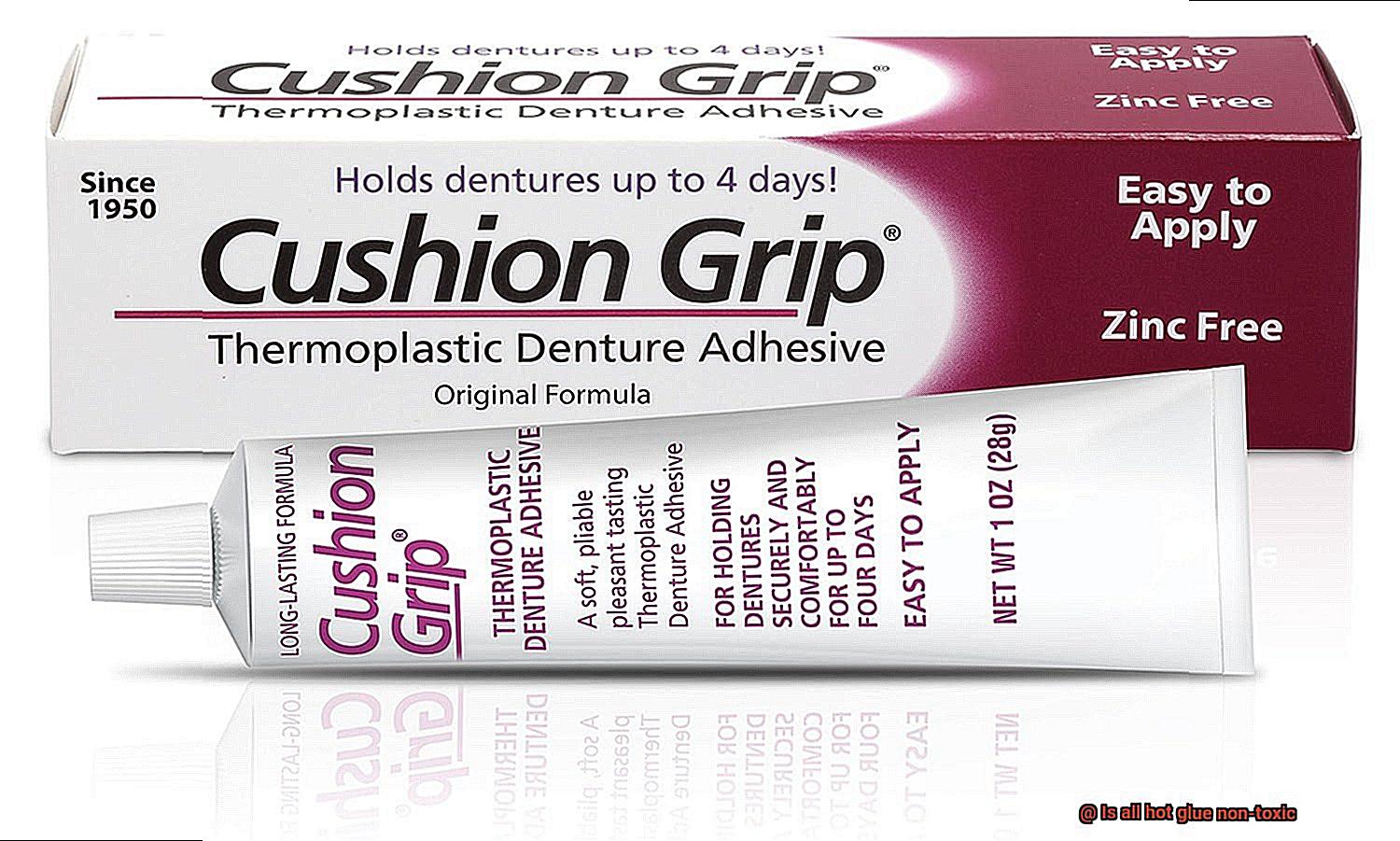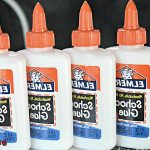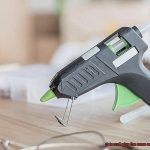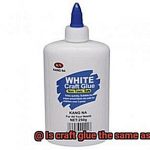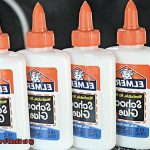Hot glue, the crafters’ secret weapon, is adored for its versatility and strong bonding power. Whether you’re a seasoned pro or just starting out, chances are you’ve dabbled with hot glue. But have you ever stopped to wonder about its safety? Is all hot glue non-toxic? In this blog post, we dive deep into the world of hot glue to uncover its potential risks and benefits, so you can make informed decisions about using it.
On one hand, hot glue is a crafters’ dream come true. It dries in a flash, sticks almost anything together, and lets your imagination run wild. Crafters everywhere rely on hot glue to bring their projects to life with ease.
But here’s the catch: not all hot glues are created equal when it comes to safety. While many manufacturers produce non-toxic versions, it’s essential to double-check if the specific product you’re using falls into this category. Non-toxic hot glue eliminates any worries about harmful chemicals, making it ideal for projects involving kids or pets.
Unfortunately, some hot glues can release volatile organic compounds (VOCs) that might irritate your respiratory system or trigger allergies. If used in poorly ventilated areas for extended periods of time, these fumes could pose health concerns. So be mindful of ventilation and use caution when tackling big projects or working in enclosed spaces.
And let’s not forget about accidental burns. Hot glue’s high temperature can cause serious burns if it touches your skin. To minimize this risk, always handle it with care and consider wearing protective gloves.
For the safest crafting experience, opt for hot glues from reputable manufacturers who prioritize product safety. Look out for non-toxic or low-VOC options and read those labels and safety instructions before diving in. If you have specific concerns or sensitivities, there are alternative adhesives out there that might better suit your needs.
In the pursuit of creativity and self-expression, it’s crucial to balance the convenience of hot glue with an understanding of potential risks. By staying informed and using safe handling practices, you can enjoy worry-free crafting while keeping yourself and those around you safe. So go forth, armed with knowledge, and let your imagination run wild.
What is Hot Glue?
Contents
Hot glue, also known as hot melt adhesive, is a versatile and quick-drying adhesive that has become a staple in the world of crafts and DIY projects. It is a thermoplastic adhesive that is applied in a molten state and solidifies as it cools down. Available in the form of cylindrical sticks or pellets, hot glue is loaded into a hot glue gun, which heats it to a liquid state for easy dispensing.
One of the key advantages of hot glue is its ability to bond a wide range of materials, including paper, fabric, wood, plastic, metal, and ceramics. This makes it an ideal choice for various crafting endeavors. Unlike other adhesives that require time to dry, hot glue sets rapidly once applied, allowing you to complete your projects faster without the need to wait for the adhesive to dry.
Another notable characteristic of hot glue is its temperature resistance. Once cooled and solidified, hot glue can withstand high temperatures without melting or losing its adhesive properties. This makes it suitable for applications where heat may be involved, such as attaching decorations to candles or securing wires in electrical projects.
While non-toxic hot glues are available on the market, it’s important to read product labels and safety information to ensure the glue being used is safe for the intended application. Some hot glues may emit fumes during the melting process, which can irritate the respiratory system. To minimize exposure to these fumes, it is recommended to use hot glue in a well-ventilated area.
Additionally, as hot glue is applied in a molten state, it can cause burns if it comes into contact with the skin. It’s crucial to handle hot glue with care and avoid direct contact with bare skin. Using protective gloves or tools designed for handling hot glue can help minimize the risk of burns.
Ingredients of Hot Glue
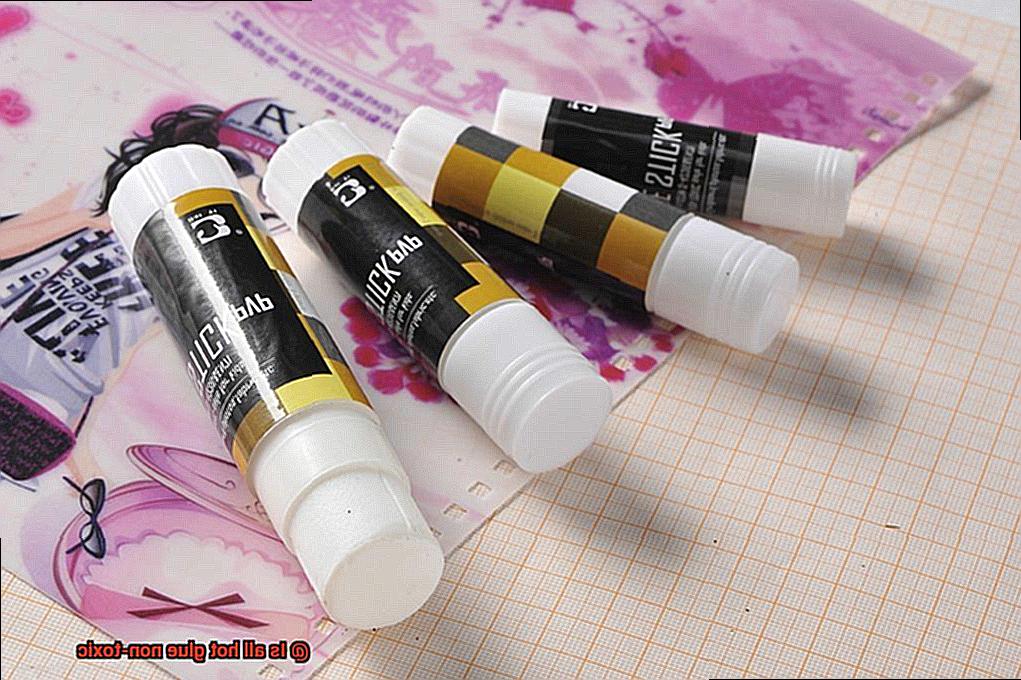
Today, we embark on a journey into the realm of hot glue, uncovering the enigmatic ingredients that bestow upon it such formidable sticking power. Brace yourselves, for we shall also explore the safety considerations you must heed.

At the heart of hot glue lies the ethylene-vinyl acetate (EVA) copolymer, the pinnacle of its composition. This marvelously named material possesses a remarkable quality: it morphs into a malleable state when exposed to heat, only to solidify with impeccable determination upon cooling. Truly, it is akin to wielding magic within a stick.
But wait. The ingredients of hot glue extend beyond the EVA copolymer, harmonizing to enhance its performance. Tackifiers dance within its depths, elevating its adhesion capabilities to heights unfathomable. Picture a gum on a shoe, stuck tighter than ever before. Stabilizers safeguard against degradation over time, ensuring your projects endure the test of time. And behold, plasticizers impart flexibility and resilience, making your glue impervious to brittleness—a sheer delight for all those who revel in the realm of bendy crafts.
Yet, let us not forget the matter of safety. Most commercial hot glues are meticulously formulated with an eye towards general use and undergo rigorous examinations to meet the stringent standards set by esteemed organizations like the Consumer Product Safety Commission (CPSC). Nevertheless, it is prudent to note that certain hot glues may contain solvents such as toluene or xylene, substances that warrant caution if ingested or inhaled excessively.
To ensure your safety amidst hot glue endeavors, always adhere to the instructions provided on the packaging. Resist any temptation to taste-test this adhesive marvel—seriously. Work within well-ventilated spaces to minimize exposure to fumes and take respite should dizziness ensue. Should any concerns arise regarding a particular hot glue product, seek guidance from the manufacturer or seek out safety certifications adorning the packaging.
Safety Concerns Regarding Hot Glue
In this article, we will explore the key considerations to keep in mind when working with hot glue.
Burns:
Hot glue guns operate at high temperatures to melt the adhesive, making burns a significant risk. To prevent accidents, exercise caution and avoid touching the heated tip or any freshly applied glue. It is wise to wear heat-resistant gloves and use a heat-resistant mat when working with hot glue.
Fumes:
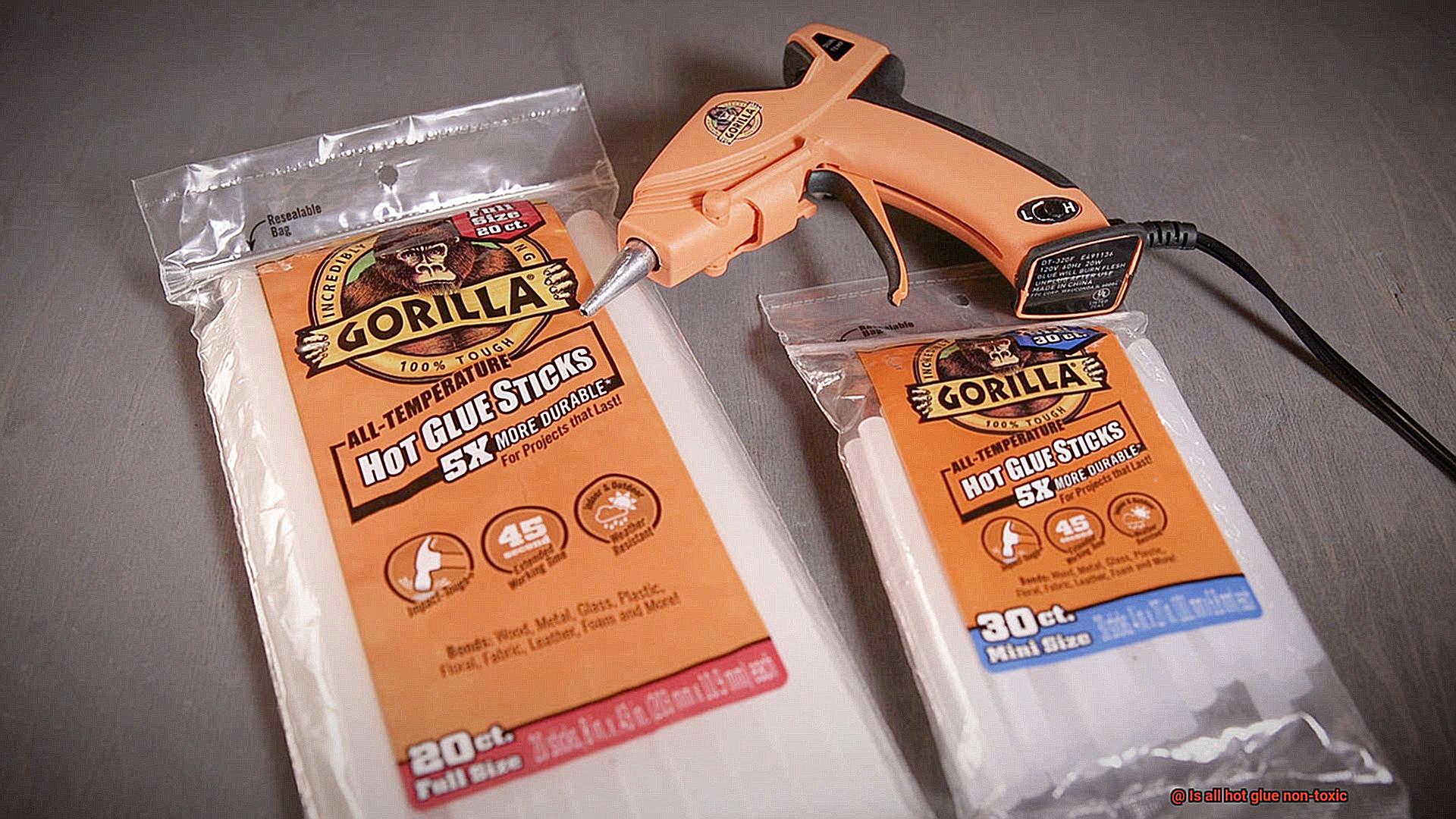
When hot glue is melted, it can release potentially harmful fumes. Working in a well-ventilated space or using a fan to disperse any fumes is essential, especially for larger projects or frequent use of hot glue.
Ingestion:
Accidental ingestion of hot glue can occur, particularly among children and pets. To prevent choking hazards or gastrointestinal issues, keep hot glue sticks out of reach and store them securely. Always supervise children when using hot glue and educate them about its potential dangers.
Toxicity:
While many manufacturers produce non-toxic hot glue sticks, it’s important to check product labels for safety warnings or certifications indicating non-toxicity. Some hot glues may contain additives or chemicals that could be toxic if ingested or inhaled. If unsure about the toxicity of a particular brand, consider contacting the manufacturer for clarification.
Personal Protective Equipment (PPE):
Protect yourself by wearing appropriate PPE when using hot glue. Heat-resistant gloves, safety goggles, and long-sleeved clothing can help prevent burns and accidental exposure.
Proper Storage:
After use, allow the hot glue gun to cool down before storing it in a safe place. Keep glue sticks in a dry and cool environment to prevent melting or deterioration.
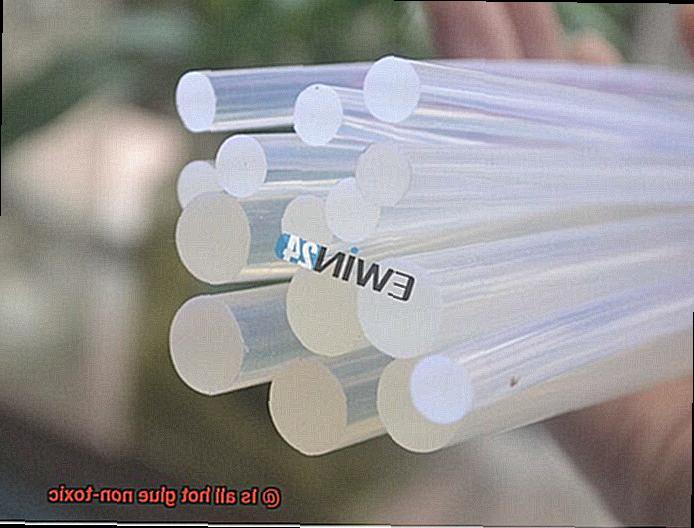
Potential Fumes From Hot Glue
While it is known for its quick-drying and versatile nature, hot glue can also release fumes that may be harmful if not handled properly. These fumes contain volatile organic compounds (VOCs) and can irritate the respiratory system, leading to symptoms such as headaches, dizziness, nausea, and respiratory irritation.
To minimize your exposure to hot glue fumes, there are several precautions you can take. First and foremost, it is crucial to work in a well-ventilated area. Opening a window or using a fan will ensure fresh air circulation and help dissipate any fumes. If you are particularly sensitive to fumes or have pre-existing respiratory conditions, consider wearing a respirator or mask designed for chemical fume protection.
Furthermore, it is important to follow the manufacturer’s instructions when working with hot glue. This includes using the glue at the recommended temperature and avoiding direct contact with your skin to prevent burns. Additionally, if you are concerned about the potential health risks of hot glue fumes or have heightened sensitivity to them, there are alternative adhesive options available. Look into low-odor or non-toxic glues that are safer and can still get the job done.
Lastly, if you experience any adverse health effects while working with hot glue, such as difficulty breathing or severe irritation, do not hesitate to seek medical attention. Your health and well-being should always be a priority.
Risk of Burns from Hot Glue
Hot glue, the superhero of the craft world, possesses mighty adhesive powers that can stick almost anything together. However, like any superhero, it comes with its fair share of risks. One of the most significant risks associated with hot glue is the potential for burns. These burns can be quite severe and should not be taken lightly.
Hot glue guns can reach scorching temperatures of up to 375°F (190°C), hotter than a sizzling summer day at the beach. When this blazing hot glue makes contact with your skin, it has the potential to cause immediate pain, redness, and even blistering. It’s a crafting catastrophe waiting to happen.
To avoid these fiery burns, it is crucial to handle hot glue guns with caution. Treat them as if they were fire-breathing dragons, respecting their power. Wearing protective gloves is highly recommended to shield your precious skin from accidental drips or spills. Additionally, using a heat-resistant mat can catch any stray glue and further minimize the risk of burns.
Here’s a pro tip: never touch the nozzle or any freshly applied hot glue until it has thoroughly cooled and solidified. Although it may be tempting to test its stickiness or poke at it, the potential risk of a burn far outweighs any curiosity. Give the glue sufficient time to cool down and harden before investigating further.
In the unfortunate event that you do suffer a burn from hot glue, there’s no need to panic. Simply run cool water over the affected area for at least 10 minutes. This will help alleviate pain and prevent further damage. However, if the burn is severe or doesn’t show signs of improvement, seeking medical attention is essential. It’s always better to err on the side of caution when it comes to our health.
Choosing Non-Toxic Hot Glue
Hot glue is a powerful adhesive that holds the potential to bond almost anything together, making it a beloved tool for crafters worldwide. However, when working with hot glue, especially in the presence of children, safety should be a top priority. In this comprehensive guide, we will delve into the world of non-toxic hot glue sticks, equipping you with essential tips to ensure a safe and enjoyable crafting experience.
Verify Non-toxic Claims:
While many hot glue sticks claim to be non-toxic, it is crucial to go beyond mere claims. Take the time to scrutinize the product label or conduct further research to confirm that the glue stick does not harbor harmful chemicals like formaldehyde. Look for certifications or labels from esteemed organizations such as ASTM International or the Art and Creative Materials Institute (ACMI), which rigorously test and certify products for their non-toxicity and safety.
Opt for Natural or Plant-based Glue Sticks:
Consider selecting hot glue sticks crafted from natural or plant-based materials. These eco-friendly alternatives derive from renewable resources and eschew harmful chemicals. They provide a safer option without compromising on bonding strength or performance.
Water-based vs. Solvent-based Glues:
When making your hot glue selection, favor water-based glues over their solvent-based counterparts. Water-based glues generally exhibit lower toxicity levels and emit milder odors, contributing to a more pleasant crafting experience.
Research Customer Reviews:
Before committing to a purchase, peruse customer reviews and feedback related to the non-toxicity of specific hot glue brands. This additional due diligence will provide you with added assurance that you are choosing a safe option for your creative projects.
Consider Additional Factors:
While prioritizing non-toxicity, do not neglect other important factors such as bonding strength, drying time, and compatibility with various materials. Seek out a hot glue stick that fulfills your specific project requirements while maintaining its non-toxic properties.
Benefits of Non-Toxic Hot Glue
Prepare to be amazed by the wonders of non-toxic hot glue. This revolutionary adhesive offers a multitude of benefits that not only ensure your safety but also take your projects to new heights. In this blog post, we will explore the diverse advantages of non-toxic hot glue, from its safe and eco-friendly nature to its versatility, accessibility, and ease of use. So grab your trusty glue gun and let’s dive into the world of non-toxic hot glue.
Safety First:
Non-toxic hot glue is a game-changer for projects involving children or individuals with respiratory sensitivities. Say goodbye to worries about harmful fumes. This glue eliminates any potential health risks, providing a safe environment for everyone involved. Rest easy knowing that even if little ones accidentally touch their creations, no harm will come their way.
Environmentally Friendly:
By choosing non-toxic hot glue, you’re not only protecting yourself but also our precious planet. Crafted from natural ingredients or biodegradable materials, this glue is eco-friendly and won’t harm the environment when properly disposed of. Craft with a clear conscience.
Versatile Adhesion:
Non-toxic hot glue is a true jack-of-all-trades when it comes to bonding various materials securely. Whether you’re working with paper, fabric, wood, or plastic, this adhesive will provide a strong hold for your projects. The possibilities are endless.
Quick Drying Time:
In the world of crafting, time is of the essence. Thankfully, non-toxic hot glue delivers on speed. With its quick drying time, you can efficiently complete your projects without unnecessary waiting. Perfect for time-sensitive tasks or professionals seeking fast turnarounds.
Affordable and Accessible:
Crafting should be a joy, not a financial burden. Non-toxic hot glue understands this, offering affordability without compromising quality. Find this adhesive readily available at most craft stores, hardware stores, and online retailers. It’s a win-win.
Easy to Use and Remove:
No need for complicated tools or equipment with non-toxic hot glue. Simply grab your hot glue gun and watch your ideas come to life. And if mistakes happen or you need to reposition your work, no worries. This glue can be softened with heat and peeled off effortlessly, leaving no residue or damage behind.
Tips for Safely Using Hot Glue
Hot glue is a versatile and quick-drying adhesive that is commonly used in arts and crafts projects. While it offers many benefits, it is important to prioritize safety when working with hot glue to prevent accidents and injuries. In this guide, we will discuss five essential safety tips for using hot glue.
Protect Yourself:
When using hot glue, it is crucial to protect yourself from burns. Hot glue guns can reach high temperatures, so always handle them with care. Wear protective gloves to prevent direct contact with the hot glue and reduce the risk of burns. Additionally, work on a heat-resistant surface to avoid any accidental spills or drips.
Choose a Well-Ventilated Area:
Using hot glue in a well-ventilated area is essential. The melting process can release fumes that may irritate your respiratory system. Open windows or use a fan to improve air circulation while working with hot glue. This will help minimize the inhalation of potentially harmful fumes.
Keep Kids and Pets Away:
Hot glue guns can be dangerous, especially for children and pets. Always keep them away from your work area to prevent accidents. Remember, safety should always come first.
Clean Up Spills Immediately:
Hot glue hardens quickly, so it’s important to clean up any spills or excess glue immediately. Use a damp cloth or sponge to wipe away the excess before it becomes too rigid. This will prevent any potential accidents caused by slipping on the hardened glue or accidentally touching it.
Proper Storage:
After using hot glue, unplug the glue gun and allow it to cool down completely before storing it in a safe place away from children or pets. Store your hot glue sticks in a cool, dry place to prevent them from melting or becoming unusable. This will ensure that the glue gun and sticks are safely stored and ready for future use.
hu8sJBctzFc” >
Conclusion
In conclusion, it is important to note that not all hot glue is non-toxic.
While many brands and types of hot glue are designed to be safe for use, there are some varieties that may contain harmful chemicals. It is crucial to read the label and choose a hot glue that specifically states it is non-toxic.
Additionally, it is recommended to work in a well-ventilated area when using hot glue to minimize the inhalation of any fumes.

